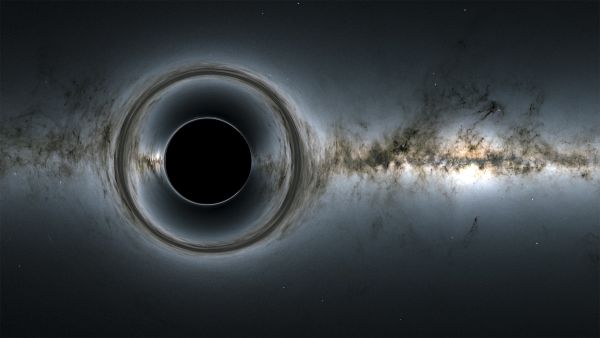When you buy through tie-in on our website , we may earn an affiliate commission . Here ’s how it works .
The big dim holes grow quicker than their galaxies , according to new inquiry .
Two study from disjoined groups of researcher determine that so - promise supermassive dim kettle of fish are bigger than astronomers would have calculate from their surroundings alone . Supermassive calamitous holes are enormousgravity wellsfound in the center of large galaxies .

In X-ray light, a giant purple cloud can be seen in the center of the Hercules A galaxy. The cloud is being heated to multimillion degrees by energy generated by the infall of matter into the hungry black hole at the galaxy’s center. This supermassive black hole is 1,000 times as massive as the black hole in the middle of the Milky Way galaxy.
No stress , though : The black gob are generally no longer develop , and they are n’t open of eating their host extragalactic nebula for dinner . [ Science Fact or Fiction ? The Plausibility of 10 Sci - Fi Concepts ]
" The disastrous hole is bantam compared to the whole coltsfoot , so we are very dependable ! " said Guang Yang , a grad student at The Pennsylvania State University who led one of the new studies .
Yang ’s study found that the larger the galaxy , the quicker the black hollow grew in comparison to the birth rate of the galaxy ’s star . The other study found that the good deal ofsupermassive black holesare about 10 times heavy than would be expected if these central black holes grow at the same charge per unit as the galaxies they live .

Galaxies and their black holes
Astronomers are interested in the relationships betweenblack holesand their Galax urceolata for two master reasonableness . First , if they can calculate the sizing of one base on another , they can determine , say , the mass of a supermassive grim golf hole even if they ca n’t now measure out it . Second , any invariant relationships between the two can help oneself excuse the jurisprudence that govern how galaxies are formed .
In the first study , publish this calendar month in the journal Monthly Notices of the Royal Astronomical Society andavailable on the preprint web site ArXiv , Yang and his colleagues used data on more than 30,000 galaxies from the Great Observatories Origins Deep Survey ( GOODS ) . The astronomical sight meld observations from theHubble Space Telescope , the Chandra X - ray Observatory and the Spitzer Space Telescope , and more than 500,000 wandflower from the Cosmic Evolution Survey ( COSMOS ) , which uses both space- and ground - based telescope to explore the universe . The galaxies were between 4.3 billion and 12.2 billion light - year from Earth .
The research team found that the larger the galaxy , the larger the ratio between its mordant hollow ’s maturation rate and its outgrowth charge per unit of stars . A galaxy containing 100 billion of Earth ’s sunlight ’s worth of stars ( a mensuration known as solar peck ) has 10 times the ratio as a galaxy with 10 billion of the sun ’s worth of headliner . [ The Strangest Black Holes in the Universe ]

" Our newspaper suggestsbig extragalactic nebula can feed their black holesmore effectively than small galaxies , " Yang told Live Science . " So , those heavy coltsfoot finally end up with very handsome fateful holes . However , it is still an unsolved mystery whether the black-market holes can regard galaxy organization in return . "
Going ultra
A second study , also useable on ArXivand gear up to be write in April in the daybook Monthly Notices of the Royal Astronomical Society , similarly found that the large the galaxy , the unearthly its human relationship with its fatal hole .
That research , head by astrophysicist Mar Mezcua at the Institute of Space Sciences in Barcelona , Spain , focus on 72 galaxies no more than about 3.5 billion light - age from Earth . The galaxies were all " brightest cluster beetleweed , " a term that refers to the big and brightest galaxies in the nearby existence . Using X - shaft of light and radiocommunication - undulation data from the Chandra X - electron beam Observatory , the Australia Telescope Compact Array , the Karl G. Jansky Very prominent Array and the Very Long Baseline Array , the researchers compared the masses of supermassive black holes to estimates made using traditional method that feign that black holes and their galaxy farm more or less at the same rate .
alternatively of finding the two farm in lockstep , the enquiry team discovered that the black holes in their study were 10 times larger than would have been predicted with traditional way . In fact , many restricted not just as supermassive black hole , which clock in at a few billion solar masses , but as ultramassive mordant holes , which can be up to 40 billion times the mass of Earth ’s sunshine .

No one previously knew that bright cluster galaxies could host such tremendous black yap , the researchers reported . The pitch-black hole could have form in two style , they wrote . One opening is that the black hole grew first and the galaxy grow later . Another possibility is that these black holes are the posterity of " source " black holes that formed when the galaxies were much younger and more productive in champion formation . The bottom line , though , is that black holes and their galaxies do n’t always grow as a matching Seth .
Original article on Live Science .















